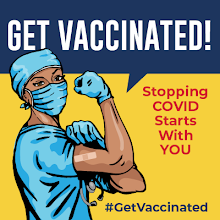Also, will everyone please stop saying "cases are rising BUT hospitalizations are low", as if that cancels out the number of cases? What happens when hospitalizations do rise, or when the next variants & their mutations are more serious? Nobody is talking about those possibilities.
------------------------
From Mary Whitfill Roeloffs at Forbes, 8/18/24:
Summer COVID Surge: Cases Rise In 25 States—But New Vaccines On The Way
Topline:
"A summer COVID-19 surge has led to a likely rise in infections in half of U.S. states, according to the Centers for Disease Control and Prevention, a spike that comes as drug makers await approval for new vaccines that will target the coronavirus’ latest variant—though hospitalizations remain fairly low.
Key facts:
"COVID-19 infections are growing in 14 states and likely growing in another 11, according to CDC data from Tuesday, the most recent data available, with only five states expected to be currently experiencing a decline in cases (figures are stable or unclear in the other 20 states).
"Levels of SARS-COV-2—the virus that causes COVID-19—in wastewater are "very high" in 33 states including Texas, Florida and California, six more than reported the week before, and "high" in another 11, CDC data released Thursday shows—a common early indicator for jumps in coronavirus infections.
"Covid cases have surged over the summer for the last several years due to the emergence of more transmissible variants, people gathering indoors to escape the summer heat and jumps in travel, according to Johns Hopkins.
"This year's summer surge could end up being the largest seen in the season since the virus first started circulating in 2020, public health expert Ashish Jha told NBC News, but hospitalization and death rates remain relatively low compared to those of summers past (as of May, hospitals are no longer required to report COVID information to the CDC).
"The surge has been partially attributed to three new variants that have evolved enough from their parent virus, JN.1, that immunity from past infections isn’t as effective and as millions of American children head back to school.
Contra
"Hospitalization rates remain low. As of the week ending Aug. 10, the latest data available, 3.2 people were being hospitalized due to COVID for every 100,000 people in a given area, higher than the same week in 2023 (when 2 people were hospitalized) but lower than the three seasons before (6.3 people were hospitalized in the same week in 2020, 5.8 in 2021 and 7.7 in 2022). The rate of 3.2 hospitalizations per 100,000 is also much lower than the 2023-2024 season peak of 7.8 hospitalizations per 100,000 people in late December.
Crucial Quote
“Our hospitalization rates are down, so even if we are testing and seeing more [COVID], it seems to be having less of an impact on our susceptible populations,” Michael Phillips, chief hospital epidemiologist for NYU Langone Health in New York City, told NBC.
Where Are Covid Infections Rising?
"The CDC says COVID inflections are growing or likely growing in California, Washington, Idaho, Arizona, New Mexico, North Dakota, South Dakota, Minnesota, Illinois, Nebraska, Kansas, Iowa, Arkansas, Mississippi, Kentucky, Tennessee, West Virginia, Virginia, South Carolina, Georgia, Alabama, Vermont, Massachusetts, Pennsylvania and Rhode Island. Cases are likely declining in Alaska, Hawaii, Louisiana, Florida and New York. Other states were either staying stable with their rates of COVID infection or weren't estimated by the CDC.
What To Watch For
"Updated vaccines from Pfizer, Moderna and Novavax to protect against new variants are expected to be approved as soon as next week, according to the Washington Post, and the shots could be available to the public as soon as Labor Day. COVID cases historically spike in the fall and winter months.
Tangent:
"The first COVID vaccines became available in December of 2020 for adults and booster/variant-specific shots have been made available every year since. This year’s vaccines will focus on the JN.1 variant and the KP.2 strain of the JN line, which was the most dominant variant circulating in the U.S. in May, June and most of July. The CDC recommends everyone over the age of 6 months get an updated COVID vaccine regardless of their previous vaccination status. Moderna and Pfizer's vaccine will be available for those as young as 6 months old, and Novavax’s shot will be available for those 12 years and older.
Surprising Fact
"Drug manufacturers are also working to create a combined vaccine that would inoculate against COVID and influenza at the same time. The combined shot from Moderna had promising clinical trial results, The Washington Post reported, and could be available as soon as next year.
Key Background











.jpg)
No comments:
Post a Comment